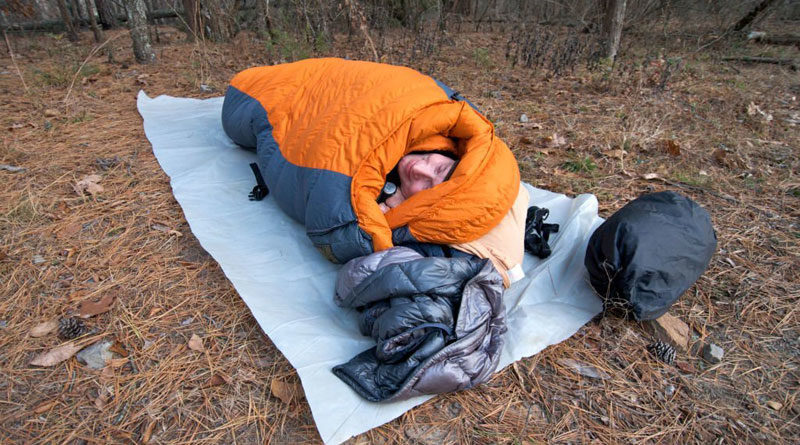How Much Difference Does A Sleeping Bag Liner Make?
So, you want to get yourself something that adds some warmth to your sleeping bag without adding a ton of weight. Or, maybe, you have started to realize that it is difficult to wash a sleeping bag and it would be better to get a layer to protect the bag.
You may have probably heard of sleeping bag liners at this point. But should you get one? And how much difference do they make? Unfortunately, sleeping bag liners are one of the most underrated pieces of gear. Many backpackers and campers don’t even consider it as something useful. But you don’t know what you are missing.
Reasons to use a liner
If you haven’t used a liner till now, you should start now. Using a liner has many benefits. It adds warmth to your sleeping bag without you having to buy another sleeping bag. It also prolongs the life of your sleeping bag.
The liner protects the bag from dirt, sweat, and oil from your skin so you don’t have to wash your sleeping bag. Washing the sleeping bag impacts longevity. A liner is also easier to wash than a sleeping bag.
Most liners are machine washable using standard laundry detergent. Just avoid using fabric softeners as they affect the moisture-wicking properties of the liner material. You just air dry the liner like your clothes and you are done.
Washing a sleeping bag requires much more effort and it also damages the fill inside, especially, if you have a down sleeping bag. Furthermore, liners can be used on their own if you are camping in hot conditions. You can use your sleeping bag as a pad and stay in your liner.
Liners also add a layer of protection against insect bites. If you are heading in an area where insects will be an issue, you can choose a silk liner as provides the best protection against insects.
Does a sleeping bag liner add any warmth?
There are mixed opinions about liners adding warmth to the sleeping bag in general. However, there are liners specially designed to provide warmth. But generally speaking of a liner, the warmth it provides depends on the material it is made of.
Manufacturers make different claims about their liners providing 5°F of warmth at the lower up to 32°F of warmth. But most people are skeptical about these figures and they tell you to expect the performance to be half of what is advertised.
What material is a liner made of?
- Silk
- Cotton
- Microfiber
- Merino Wool
- Fleece, Microfleece
- Insulated
- Thermal Synthetic
Insulated and Thermal Synthetic Liners
The material of the liner depends on your intended use. If you are looking to add warmth to your sleeping bag, then you would want to go with insulated or thermal synthetic liners which can add up to 25°F to 32°F of warmth to your sleeping bag. But these liners are also heavy and will add weight to your gear.
Fleece, Microfleece
If you are looking for a balance between weight and warmth, a fleece or microfleece liner is ideal for you. These liners add up to 12°F to your sleeping bag which is enough to turn a summer sleeping bag into a 3-season sleeping bag.
Silk
If weight is a concern, choose silk liners. These are the most lightweight and comfortable liners. They add softness to your sleeping bag, keep it clean, and protect you from insects. But silk liners are expensive. Silk liners add about 5°F of warmth to your sleeping bag.
Cotton
Cotton liners are bulkier and heavier than silk liners. Unlike silk liners, cotton liners don’t wick away moisture and don’t breathe as well. But cotton costs less and is a more durable material than silk and the weight difference is little. Cotton liners are widely used among campers. Just like silk liners, cotton liners also add about 5°F to your sleeping bag.
Merino Wool and Microfiber
Microfiber and merino wool liners add about 5 to 10°F to your sleeping bag. Both of these materials are very comfortable and provide you with a comfortable sleeping experience. But, just like silk, both are expensive. Both have moisture-wicking properties but merino wool also has anti-odor and anti-bacterial properties.
The shape of sleeping bag liners
Sleeping bag liners are available in two types of shapes to fit different shapes of sleeping bags. These are either mummy-shaped or rectangular-shaped. Mummy-shaped liners are made to fit in a mummy sleeping bag while regular-shaped liners are for a sleeping bag having a rectangular or a semi-rectangular shape.
Sea to Summit Premium Silk Travel: Best Liner for Comfort
Shape: Rectangular
Dimensions: 88 x 36 in.
Materials: Silk
Weight: 6 oz.
Sea to Summit has quite a range of sleeping bag liners of all kinds and they are among the best liners in the market. The Sea to Summit Premium Silk Travel Liner is an option worth considering if you want to protect your bag from getting dirty along with comfortable sleep. Being a silk liner, you can expect it to be expensive but the features justify the high price. The liner is well-made and has a high-quality feel. It has an integrated hood, double-stitching for durability, stretchy side panels for easy entry and exit, and ripstop silk.
The liner is extremely lightweight weighing in at just 6 ounces along with an extremely small pack size. But, perhaps, the greatest feature of this liner is that it is machine washable. Silk liners are easy to rip so they require handwashing which makes this feature a big deal. The liner is available and different shapes and sizes including mummy, rectangular, long rectangular, and even double so you probably won’t have sizing issues.
What I like: Machine washable, ripstop silk, lightweight, durable, and stretchy panels for easy entry and exit
What I don’t: High price
See the Sea to Summit Premium Silk Traveller
Sea to Summit Reactor Thermolite: Best For Warmth
Shape: Mummy
Dimensions: 82 x 35 in.
Materials: Polyester
Weight: 8.1 oz.
Sea to Summit Reactor Thermolite liner is an insulated liner that adds up to 15°F to your sleeping bag. In addition to providing warmth, it is also lightweight and packs into a small size. It has a longer length than other liners but weighs only 8.1 oz. That’s light for a liner that provides that much warmth.
The Reactor is a decent performer when compared to high-end liners. You can use the Reactor as a light blanket on its own. It can add significant warmth to your sleeping bag in the cold and you can also skip a sleeping bag while camping in the summer with this liner. The Reactor also has a Reactor PLUS model which provides even more warmth.
But this liner is expensive and while it does perform well, it would be better if it were a bit more affordable. It doesn’t feel as soft as other liners as well which compromises its ability to provide comfort. But overall, it’s one of the warmest liners you can get on the market.
What I like: Provides great warmth, lightweight, small pack size, and longer length
What I don’t: Relatively pricey, not as soft feeling as other comparable liners
Final Thoughts
Many people underestimate the use of a sleeping bag liner. But it can provide warmth in addition to your sleeping bag and also protect the sleeping bag from dirt and sweat. A liner results in far less washing of your sleeping bag allowing it to last longer.
While many people argue that liners provide the warmth claimed by the manufacturers, they can still be useful in adding warmth to your sleeping bag. The warmth of the liner depends on the material it is made of. The material you choose depends on the intended use of the liner, that is, you want warmth or you want to protect your sleeping bag.
Sleeping bag liners are also easier to maintain as most of them are machine washable and require no sophisticated treatment. Sleeping bags, on the other hand, need to be handled carefully during cleaning, especially, if they are down sleeping bags.
Considering they provide such convenience and add little weight and cost to your overall gear, you should seriously consider getting a sleeping bag liner.






